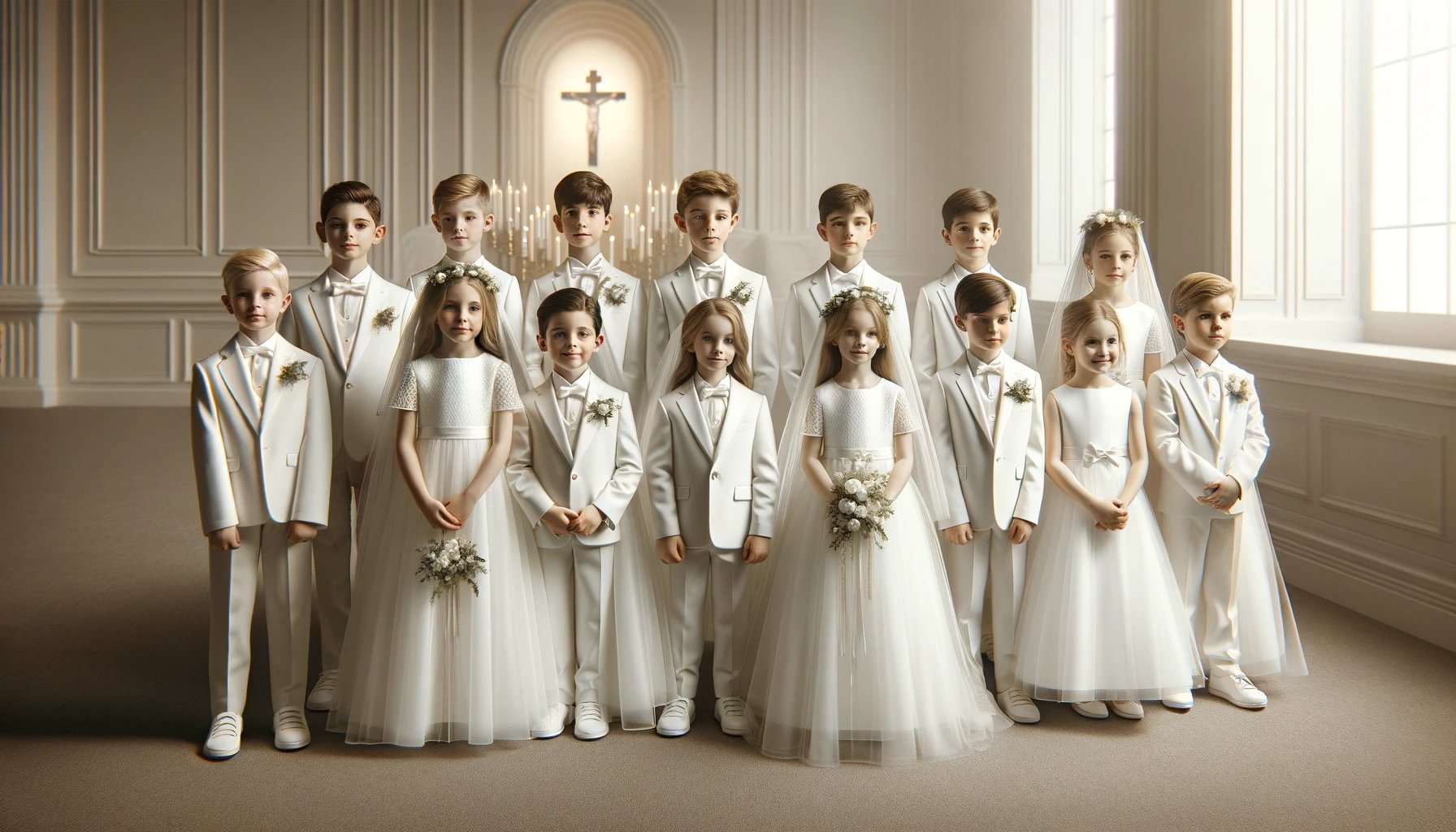Home>Arts and Culture>When To Wear A Chapel Veil


Arts and Culture
When To Wear A Chapel Veil
Published: March 4, 2024
Jason DeRose, Managing Editor at Christian.net, uses his expertise in religion and journalism to deepen understanding of faith's societal impacts. His editorial leadership, coupled with a strong academic background, enriches the platform’s diverse content, earning him recognition in both journalism and religious circles.
Discover the significance of wearing a chapel veil and the cultural and religious contexts in which it is traditionally worn. Explore the art and culture of chapel veils and when to wear them.
(Many of the links in this article redirect to a specific reviewed product. Your purchase of these products through affiliate links helps to generate commission for Christian.net, at no extra cost. Learn more)
Table of Contents
Reasons for Wearing a Chapel Veil
Wearing a chapel veil is a deeply personal and spiritual choice for many women. It is a symbol of reverence and humility before God, and it holds significant meaning in various religious traditions. Here are some reasons why women choose to wear a chapel veil:
-
Symbol of Modesty: For many women, wearing a chapel veil is a way to outwardly express their inner sense of modesty and humility. It serves as a reminder to focus on inner beauty and spiritual devotion rather than outward appearance.
-
Tradition and Custom: In some religious communities, wearing a chapel veil is a long-standing tradition that has been passed down through generations. It is a way to connect with the customs of their faith and show respect for the practices of their ancestors.
-
Sign of Respect: Wearing a chapel veil is often seen as a sign of respect and reverence in places of worship. It is a way to show honor and deference to the sacred space and the presence of the divine.
-
Spiritual Encounters: Some women believe that wearing a chapel veil creates a sense of intimacy and reverence during prayer and worship. It is seen as a way to create a sacred space for spiritual encounters and deep connection with the divine.
-
Cultural Identity: In certain cultures, the chapel veil is a symbol of cultural identity and heritage. It is worn as a way to honor and preserve the customs and practices of their cultural background.
-
Personal Devotion: For many women, wearing a chapel veil is a personal expression of their devotion to their faith and their desire to live out their religious beliefs in a tangible way.
-
Scriptural Basis: In some religious traditions, there are scriptural references that are interpreted as supporting the practice of women wearing a head covering during worship and prayer. This provides a theological foundation for the practice.
The decision to wear a chapel veil is a deeply personal one, influenced by a combination of religious, cultural, and individual factors. It is a practice that holds deep significance for many women and is a visible symbol of their faith and devotion.
Read more: When Was The Sistine Chapel Restored
Different Styles of Chapel Veils
When it comes to chapel veils, there are various styles to choose from, each with its own unique characteristics and symbolism. Here are some of the most common styles of chapel veils:
-
Mantilla Veils: These veils are traditionally circular or triangular in shape and are often made of delicate lace or sheer fabric. Mantilla veils drape over the head and shoulders, creating a soft and elegant look. They are popular in many Latin American and European cultures and are often worn during religious ceremonies and special occasions.
-
Infinity Veils: Infinity veils are designed with a unique shape that allows them to stay in place without the need for pins or clips. They are often made of soft, flowing fabric and are known for their simplicity and ease of wear. Infinity veils are favored by many women for their practicality and comfort during worship.
-
Chapel Caps: Chapel caps, also known as snoods, are a smaller and more fitted style of chapel veil. They are often made of lace or crocheted fabric and are designed to cover the crown of the head. Chapel caps are a popular choice for women who prefer a more understated and traditional look.
-
Mantilla Combs: These veils are attached to a decorative comb that is worn at the crown of the head. Mantilla combs are often adorned with intricate designs and embellishments, adding a touch of elegance to the veil. They are a popular choice for formal religious ceremonies and celebrations.
-
Bandeau Veils: Bandeau veils are a modern take on the traditional chapel veil. They are designed to be worn across the forehead, creating a sleek and minimalist look. Bandeau veils are often made of sheer fabric and are favored by women who appreciate a contemporary and stylish aesthetic.
-
Juliet Cap Veils: These veils feature a close-fitting cap that covers the crown of the head, adorned with lace or embellishments. Juliet cap veils are reminiscent of vintage bridal styles and are often chosen for their romantic and timeless appeal.
Choosing the right style of chapel veil is a personal decision that often reflects individual preferences, cultural influences, and the significance of the occasion. Whether opting for a traditional mantilla veil or a modern bandeau veil, each style carries its own beauty and symbolism, adding a meaningful touch to the act of worship and spiritual devotion.
How to Choose the Right Chapel Veil for You
When it comes to choosing the right chapel veil, there are several factors to consider to ensure that it aligns with your personal style, cultural background, and the significance of the occasion. Here are some tips to help you select the perfect chapel veil for your needs:
-
Consider the Occasion: The first step in choosing a chapel veil is to consider the specific occasion or event for which you will be wearing it. Different occasions may call for varying levels of formality and symbolism, so it's important to select a veil that is appropriate for the setting.
-
Reflect on Personal Style: Your personal style and preferences play a significant role in choosing a chapel veil. Whether you prefer a traditional and ornate mantilla veil or a more modern and understated bandeau veil, selecting a style that resonates with your individual taste is essential.
-
Take Cultural Influences into Account: If you have cultural or religious traditions that influence the choice of chapel veil, it's important to honor and respect those influences. Consider veils that align with your cultural background and hold significance within your community.
-
Consider Comfort and Practicality: Depending on the duration of wear and the activities involved, consider the comfort and practicality of the veil. Infinity veils, for example, are known for their ease of wear and practicality, while mantilla veils may offer a more formal and elegant appearance.
-
Symbolism and Meaning: Some chapel veils carry specific symbolism and meaning. Reflect on the significance of the veil within your religious or cultural context and choose a style that resonates with the symbolism you wish to convey.
-
Consult with Religious Authorities: In some religious traditions, there may be guidelines or recommendations regarding the appropriate style of chapel veil for specific occasions. Consulting with religious authorities or community leaders can provide valuable insights into the selection process.
-
Try Different Styles: If possible, try on different styles of chapel veils to see how they complement your overall appearance and resonate with your personal beliefs. This can help you make an informed decision based on how the veil makes you feel and the message it conveys.
By considering these factors, you can choose a chapel veil that not only aligns with your personal style and cultural background but also holds deep significance within the context of your faith and spiritual practices. The right chapel veil can serve as a meaningful expression of reverence and devotion, enriching your spiritual experiences and connections.
Etiquette for Wearing a Chapel Veil
When it comes to wearing a chapel veil, there are certain etiquette guidelines that can help ensure that the practice is approached with respect and reverence. Whether attending religious services, ceremonies, or events, observing proper etiquette when wearing a chapel veil is essential. Here are some key points to consider:
-
Respect the Sacred Space: When entering a place of worship, it is important to be mindful of the sacredness of the space. If chapel veils are customary in your religious tradition, wearing one is a way to show respect for the sanctity of the environment and the divine presence.
-
Understanding Cultural Norms: In some religious and cultural contexts, chapel veils are a customary practice with specific guidelines. It is important to familiarize yourself with the cultural norms and expectations surrounding the wearing of chapel veils to ensure that you are observing the appropriate etiquette.
-
Proper Placement and Handling: When wearing a chapel veil, it is important to ensure that it is placed and handled with care. Veils should be positioned securely and respectfully, without drawing undue attention to the process. Avoid fidgeting with the veil during religious services or ceremonies.
-
Respect for Tradition: If chapel veils are a traditional practice within your religious community, it is important to honor and respect the tradition. Understanding the historical and cultural significance of chapel veils can deepen your appreciation for the practice and its role within your faith.
-
Considerate Behavior: When wearing a chapel veil, it is important to conduct oneself with decorum and consideration for others. This includes being mindful of movements and gestures that may affect the positioning of the veil and being respectful of others who are also observing religious customs.
-
Adhering to Religious Guidelines: Some religious traditions may have specific guidelines regarding the wearing of chapel veils, including when and where they should be worn. It is important to adhere to these guidelines as a sign of respect for the religious authority and the teachings of the faith.
-
Personal Reflection and Devotion: Wearing a chapel veil is often a personal expression of devotion and reverence. It is an opportunity for personal reflection and spiritual connection, and observing proper etiquette can enhance the depth of this experience.
-
Respect for Others' Choices: In religious and communal settings, it is important to respect the choices of others regarding the wearing of chapel veils. Whether it is a personal decision or a cultural tradition, acknowledging and respecting the choices of others fosters an environment of inclusivity and understanding.
By observing these etiquette guidelines, wearing a chapel veil can be a meaningful and respectful practice that enhances the spiritual experience and fosters a sense of reverence within religious and cultural contexts. It is a way to honor tradition, express devotion, and show respect for the sacred spaces and customs of one's faith.
When Not to Wear a Chapel Veil
There are certain situations and contexts in which it may be considered inappropriate or unnecessary to wear a chapel veil. Understanding when not to wear a chapel veil is important for respecting the customs and traditions associated with its use. Here are some instances when it may be advisable not to wear a chapel veil:
-
Non-Religious Settings: In secular or non-religious settings, wearing a chapel veil may not be necessary or relevant. For example, in social gatherings, public events, or casual outings that are unrelated to religious or cultural practices, the wearing of a chapel veil may not be expected or required.
-
Personal Discomfort: If wearing a chapel veil causes personal discomfort or distress, it is acceptable to refrain from wearing one. The decision to wear a chapel veil is a personal and spiritual choice, and individuals should not feel obligated to wear one if it conflicts with their comfort or beliefs.
-
Inappropriate Activities: Engaging in activities that may compromise the integrity or appearance of the chapel veil, such as strenuous physical activities, may warrant not wearing a veil. It is important to consider the practicality and appropriateness of wearing a chapel veil in various situations.
-
Respect for Diverse Practices: In settings where diverse religious and cultural practices are observed, it is important to be mindful of the customs and beliefs of others. If wearing a chapel veil may be misunderstood or misinterpreted in a way that could cause offense or discomfort to others, it may be advisable to refrain from wearing one.
-
Personal Choice: Ultimately, the decision to wear a chapel veil is a personal one, and there may be times when an individual chooses not to wear a veil for personal reasons. It is important to respect the autonomy and agency of individuals in deciding whether or not to wear a chapel veil in specific situations.
-
Informal Gatherings: In informal or casual gatherings where the wearing of a chapel veil is not customary or expected, individuals may opt not to wear one. Understanding the appropriate contexts for wearing a chapel veil can help individuals make informed decisions about when it is suitable to do so.
-
Cultural Sensitivity: When interacting with individuals from diverse cultural backgrounds, it is important to be sensitive to the customs and traditions of others. If wearing a chapel veil may be perceived as insensitive or inappropriate in a particular cultural context, it may be best to refrain from wearing one.
-
Personal Beliefs: Individuals who do not adhere to the practice of wearing chapel veils within their religious or cultural traditions may choose not to wear one based on their personal beliefs and convictions. Respecting the diversity of beliefs and practices is essential in fostering understanding and inclusivity.
Understanding when not to wear a chapel veil is as important as understanding when to wear one. By being mindful of the appropriate contexts and considering the comfort, beliefs, and cultural sensitivities of oneself and others, individuals can navigate the practice of wearing a chapel veil with respect and consideration.















